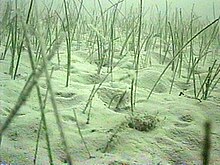Cymodocea nodosa
| Cymodocea nodosa | |
|---|---|
 |
|
| C. nodosa off the coast of Spain | |
| Scientific classification | |
| Kingdom: | Plantae |
| Clade: | Angiosperms |
| Clade: | Monocots |
| Order: | Alismatales |
| Family: | Cymodoceaceae |
| Genus: | Cymodocea |
| Species: | C. nodosa |
| Binomial name | |
|
Cymodocea nodosa (Ucria) Asch. (1870) |
|
Cymodocea nodosa is a species of seagrass in the family Cymodoceaceae and is sometimes known as little Neptune grass. As a seagrass, it is restricted to growing underwater and is found in shallow parts of the Mediterranean Sea and certain adjoining areas of the Atlantic Ocean.
C. nodosa has light green or greyish-green leaves. They are very narrow but may be up to forty centimetres long. Each leaf has seven to nine veins running along its length. The plant produces rhizomes which are only 1 mm in diameter and have leaf scars at intervals. Inconspicuous grass-like flowers are sometimes produced at the end of long stems in the spring when water temperatures begin to rise after their winter minimum. The pollen is liberated into the sea and the seeds remain dormant until the following spring.
This seagrass is found in shallow parts of the Mediterranean Sea and the adjoining parts of the Atlantic Ocean, the coasts of Portugal, Mauritania and Senegal and round the Canary Islands, Madeira and the island of Cape Verde. It grows at depths of down to ten metres in sandy sediments in sheltered locations and needs clear waters for photosynthesis.
Cymodocea nodosa grows in meadows on the seabed and is sometimes associated with the other seagrasses, Zostera noltei and Posidonia oceanica and the seaweeds Caulerpa prolifera and Caulerpa racemosa. Although it is adversely affected by mechanical disturbance such as trawling and by pollution, and although it is in competition with other seagrass species, C. nodosa is not considered to be threatened.
...
Wikipedia
